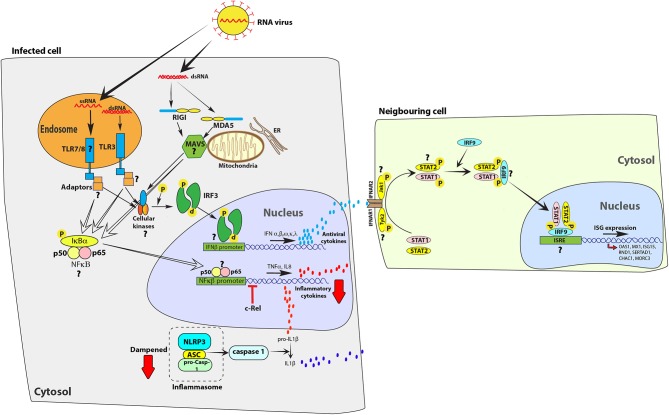Figure 1.
Bat cells mount an antiviral response to RNA viruses, but limit the expression of inflammatory cytokines. Infection with RNA viruses, such as Sendai virus, or transfecting cells with surrogate double-stranded RNA [poly(I:C)] or single-stranded RNA is detected by Toll-like receptors (TLRs) 3, 7 and 8 or cytosolic receptors retinoic acid-inducible gene-I (RIG-I) and melanoma differentiation-associated protein 5 (MDA5). Activation of these receptors activate downstream adaptor proteins, such as mitochondrial antiviral signaling protein (MAVS). Adaptor proteins activate cellular kinases, such as TANK-binding kinase 1 protein (TBK1), which in-turn activate interferon regulatory factor 3 (IRF3) or IRF7 and nuclear factor kappa-light-chain-enhancer of activated B cells (NFκB) to stimulate the expression of interferons (IFNs), such as IFNs α, β, ω, κ, and λ, and pro-inflammatory cytokines, such as IL8, TNFα, and IL1β, respectively. IFNs bind to interferon α/β receptors (IFNAR; IFNAR1 and IFNAR2) on infected and neighboring cells to activate the JAK-STAT signaling pathway via kinases such as Janus kinase 1 (Jak1) and tyrosine kinase 2 (Tyk2) that phosphorylate signal transducer and activator of transcription (STAT) proteins. Phosphorylated STAT proteins (STAT1 and STAT2) merge with IRF9 and induce the expression of interferon stimulated genes (ISGs), such as OAS1 and Mx1. However, unlike in human cells, the parallel activation of pro-inflammatory cytokines is dampened in bat cells. c-Rel, a protein from the NFκB family of proteins binds to the TNFα promoter to inhibit activation of this pro-inflammatory cytokine in E. fuscus cells (49). The bat NLRP3 inflammasome activation is dampened, reducing the ability of bat cells to produce IL1β, a key inflammatory cytokine (17). In the figure, red arrows indicate a dampened response in the pathway, relative to human cells. Question marks (?) highlight pathways and molecular homologs that have not been characterized or identified in bats. The data have been compiled from studies in different species and one finding may not represent a universal bat response. ER, endoplasmic reticulum.

